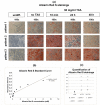Impact of Tranexamic Acid on Chondrocytes and Osteogenically Differentiated Human Mesenchymal Stromal Cells (hMSCs) In Vitro
- PMID: 33260331
- PMCID: PMC7760070
- DOI: 10.3390/jcm9123880
Impact of Tranexamic Acid on Chondrocytes and Osteogenically Differentiated Human Mesenchymal Stromal Cells (hMSCs) In Vitro
Abstract
The topical application of tranexamic acid (TXA) helps to prevent post-operative blood loss in total joint replacements. Despite these findings, the effects on articular and periarticular tissues remain unclear. Therefore, this in vitro study examined the effects of varying exposure times and concentrations of TXA on proliferation rates, gene expression and differentiation capacity of chondrocytes and human mesenchymal stromal cells (hMSCs), which underwent osteogenic differentiation. Chondrocytes and hMSCs were isolated and multiplied in monolayer cell cultures. Osteogenic differentiation of hMSCs was induced for 21 days using a differentiation medium containing specific growth factors. Cell proliferation was analyzed using ATP assays. Effects of TXA on cell morphology were examined via light microscopy and histological staining, while expression levels of tissue-specific genes were measured using semiquantitative RT-PCR. After treatment with 50 mg/mL of TXA, a decrease in cell proliferation rates was observed. Furthermore, treatment with concentrations of 20 mg/mL of TXA for at least 48 h led to a visible detachment of chondrocytes. TXA treatment with 50 mg/mL for at least 24 h led to a decrease in the expression of specific marker genes in chondrocytes and osteogenically differentiated hMSCs. No significant effects were observed for concentrations beyond 20 mg/mL of TXA combined with exposure times of less than 24 h. This might therefore represent a safe limit for topical application in vivo. Further research regarding in vivo conditions and effects on hMSC functionality are necessary to fully determine the effects of TXA on articular and periarticular tissues.
Keywords: chondrocytes; differentiation capacity; hMSCs; osteoarthritis; toxicity; tranexamic acid.
Conflict of interest statement
The authors declare no conflict of interest.
Figures






Similar articles
-
Does Combined Treatment with Tranexamic Acid and Vancomycin Affect Human Chondrocytes In Vitro?Pharmaceuticals (Basel). 2024 Nov 24;17(12):1576. doi: 10.3390/ph17121576. Pharmaceuticals (Basel). 2024. PMID: 39770418 Free PMC article.
-
Tranexamic acid toxicity in human periarticular tissues.Bone Joint Res. 2019 Feb 2;8(1):11-18. doi: 10.1302/2046-3758.81.BJR-2018-0181.R1. eCollection 2019 Jan. Bone Joint Res. 2019. PMID: 30800295 Free PMC article.
-
Short exposure to tranexamic acid does not affect, in vitro, the viability of human chondrocytes.Eur J Med Res. 2019 Feb 22;24(1):15. doi: 10.1186/s40001-019-0373-x. Eur J Med Res. 2019. PMID: 30795796 Free PMC article.
-
A comparison of combined intravenous and topical administration of tranexamic acid with intravenous tranexamic acid alone for blood loss reduction after total hip arthroplasty: A meta-analysis.Int J Surg. 2017 May;41:34-43. doi: 10.1016/j.ijsu.2017.03.031. Epub 2017 Mar 21. Int J Surg. 2017. PMID: 28336258 Review.
-
The efficacy and safety of combined administration of intravenous and topical tranexamic acid in primary total knee arthroplasty: a meta-analysis of randomized controlled trials.BMC Musculoskelet Disord. 2018 Sep 7;19(1):321. doi: 10.1186/s12891-018-2181-9. BMC Musculoskelet Disord. 2018. PMID: 30193586 Free PMC article. Review.
Cited by
-
Influence of Tranexamic Acid on Elution Characteristics and Compressive Strength of Antibiotic-Loaded PMMA-Bone Cement with Gentamicin.Materials (Basel). 2021 Sep 28;14(19):5639. doi: 10.3390/ma14195639. Materials (Basel). 2021. PMID: 34640035 Free PMC article.
-
Peri-articular administration of tranexamic acid is an alternative route in total knee arthroplasty: a systematic review and meta-analysis.J Orthop Surg Res. 2022 Apr 7;17(1):211. doi: 10.1186/s13018-022-03095-4. J Orthop Surg Res. 2022. PMID: 35392961 Free PMC article.
-
The emerging role of tranexamic acid and its principal target, plasminogen, in skeletal health.Acta Pharm Sin B. 2024 Jul;14(7):2869-2884. doi: 10.1016/j.apsb.2024.03.033. Epub 2024 Mar 30. Acta Pharm Sin B. 2024. PMID: 39027253 Free PMC article. Review.
-
Cytotoxicity of tranexamic acid to tendon and bone in vitro: Is there a safe dosage?J Orthop Surg Res. 2022 May 15;17(1):273. doi: 10.1186/s13018-022-03167-5. J Orthop Surg Res. 2022. PMID: 35570313 Free PMC article.
-
Does Combined Treatment with Tranexamic Acid and Vancomycin Affect Human Chondrocytes In Vitro?Pharmaceuticals (Basel). 2024 Nov 24;17(12):1576. doi: 10.3390/ph17121576. Pharmaceuticals (Basel). 2024. PMID: 39770418 Free PMC article.
References
-
- Fernandes A.C. Health at a Glance 2019. OECD Publishing; Paris, France: 2019. OECD Indicators.
LinkOut - more resources
Full Text Sources

